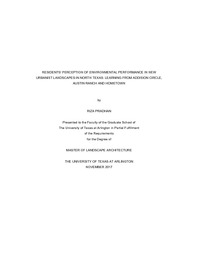| dc.description.abstract | New Urbanism movement has been shaping the cities and suburbs in increasing numbers in the US for more than three decades. The Congress for New Urbanism is promoting compact, mixed-use, interconnected, and walkable models for sustainable development. In recent years, the environmental implications of New Urbanism have not been sufficiently addressed in the literature (Spirn, 2000; Waldheim, 2010). However, the Charter of New Urbanism (Talen, 2013) highlights the importance and relevance of environmental factors. Overall, the literature lacks sufficient evidence about the environmental performance of the New Urbanist landscapes, specifically in the Dallas- Fort Worth (DFW) region.
The purpose of this research is to examine end users’ perceptions of environmental performance factors in three New Urbanist Communities in the DFW region. The study assesses the value given to environmental factors in landscapes of communities that are planned, designed and built primarily with New Urbanist principles in North Texas. The research also aims to understand the gap between the theoretical underpinnings of New Urbanism, and findings from its built projects.
This research primarily uses qualitative methods to assess environmental performance of New Urbanist communities in the DFW region (Taylor & Bogdan, 1998). The environmental performance factors studied in this research are extracted from the systematic literature review of various sources (LAF, 2017; LEED-ND, 2017; Modi et.al, 2014; SITES, 2017). Residents’ perceptions are assessed through in depth interviews in three New Urbanist developments in the DFW region, including Austin Ranch, Hometown, and Addison Circle. The study also utilized archival and secondary data as well as passive observations (Francis, 1999). Data collected through multiple techniques are analyzed to generate themes and extract findings (Sommer & Sommer, 1991) regarding the environmental performance of landscape in New Urbanist communities.
This research revealed that there are varying levels of attention given to environmental factors (i.e., vegetation, habitat creation, air quality, or stormwater management) in each New Urbanist community assessed. Although a majority of the residents highlighted some key environmental benefits for the landscapes of New Urbanist communities, there seems to be consensus on promoting greater environmental sensibility from conception to implementation of New Urbanist communities studied in DFW region. Thus, results suggest that there is a need for stronger consideration of environmental factors in the New Urbanist projects assessed here; through its ideology, its designs and development in order to provide a better environment for residents. | |


